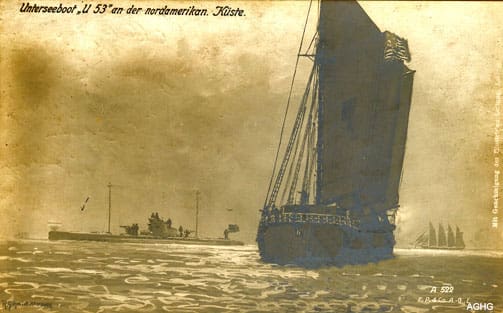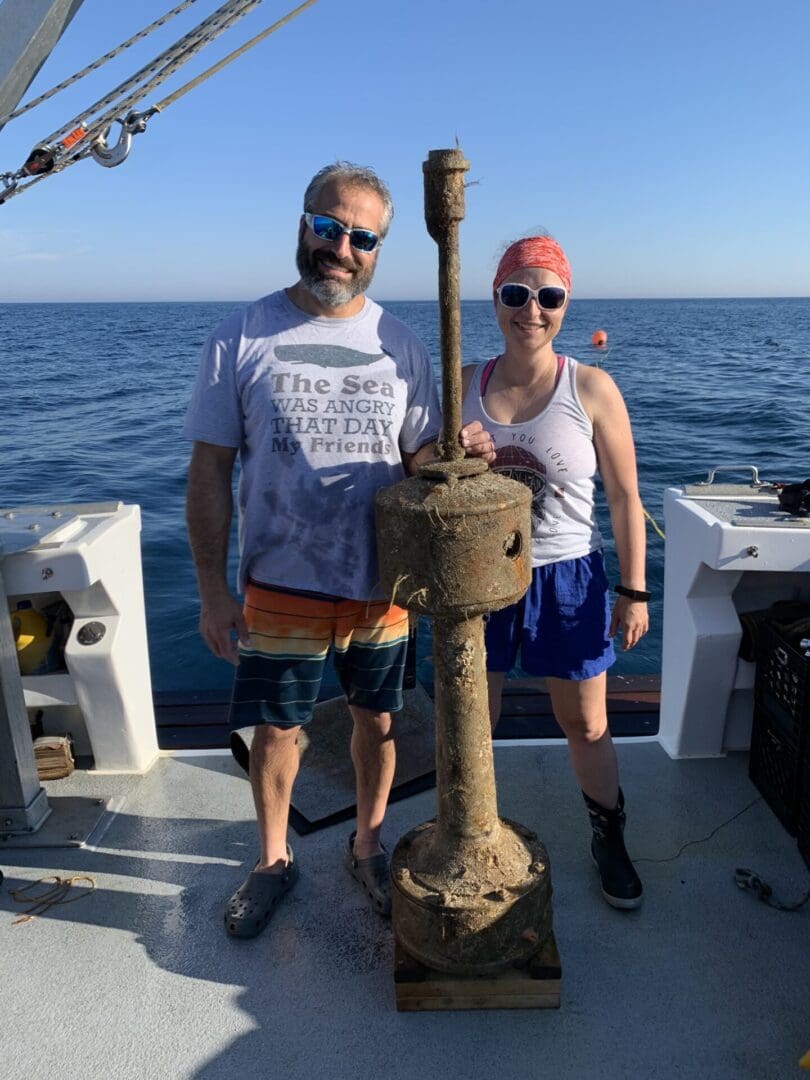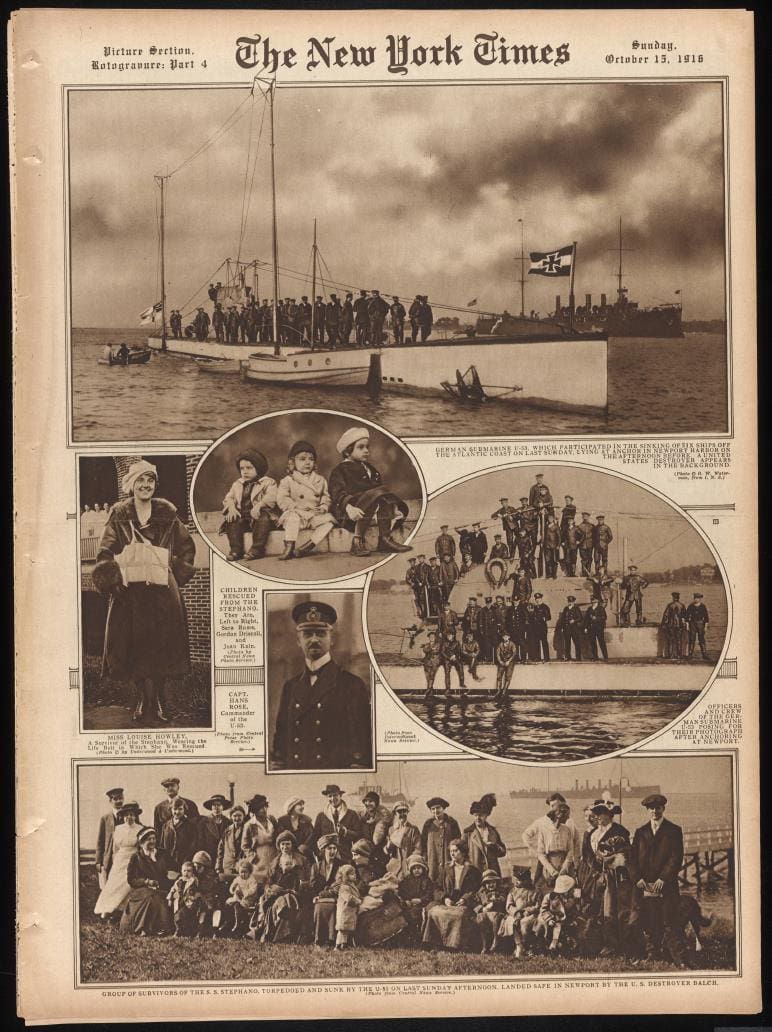Nantucket Wrecks of U-53

The U-53 crew poses with their ship just before leaving Newport Harbor.
An Unannounced Visit to Newport, Rhode Island
U-53 commander Hans Rose made an unannounced visit to the Commandant of the United States Second Naval District in Newport Harbor on the morning of October 7, 1916. America had not yet entered WWI. He met with Rear Admiral Gleaves of the American Navy before opening his U-boat to tours in Newport Harbor.

Hans Rose (left) and two of his officers at Newport.
Members of the American Navy, curious spectators who approached in small boats, and even “society girls” were all invited aboard. Captain Rose’s vessel was immaculate. His crew impressed their American guests with impeccable manners and perfect English. They served fine cakes and tea. Rose, however, was clever, and his visit to Newport was not about pleasantries. It was a calculated show of German military power. He and his crew greatly exaggerated U-53’s range and capabilities during these tours.

U-53 surrounded by pleasure craft in Newport Harbor.
Captain Rose did not risk wearing out his welcome when the tours ended. He left Newport within hours of his arrival and set to sea. The next day, U-53 sank five ships south of Nantucket. Powerless to retaliate, the Americans could only watch as the SS Stephano, SS Strathdene, SS Blommersdijk, SS West Point, and the MS Christian Knudsen were blown to the depths. The raid is now regarded as one of a series of events that drew America into WWI. The rules of warfare allowed U-53 to sink any allied ships network carrying goods, munitions, or supplies for the war effort. America had not yet declared war, so American ships were immune from German U-boat attacks but, at the same time, could not engage in attacks to assist other ships that might be in peril.
U-53 first stopped the steamship Kansan but let her go because she was American. The U-boat’s next target, the British cargo ship Strathdene, was not so lucky. Rose announced his intentions to sink the ship, allowed the crew to board boats, and sent them towards the Nantucket lightship. He torpedoed Strathdene aft. Her stern dropped but, she did not sink. He then spotted another steamer in the distance, the Norwegian tanker Christian Knudsen, which was carrying fuel to London. Captain Rose ordered the crew into boats and fired a torpedo aft. She did not sink, so he fired a second torpedo.

SS West Point, a British cargo steamer from the Furness Withy Line, became Rose’s next target. The ship continuously transmitted radio signals to warn other ships of U-53’s presence. U-53 quickly silenced her by firing two shots into the steamer’s radio room. Rose sank the ship with blast cartridges and towed her survivors to the Lightship. Next, U-53 spotted the Dutch freighter Blommersdijk.

SS Blommersdijk.
Transmissions from Kansan and other vessels in the area had alerted the American Navy that there was a U-boat sinking ships off Nantucket. The Navy sent destroyers to investigate. The destroyers approached before Rose could sink Blommersdijk, so he dove to give himself time to think. Rose had reason to be concerned. The Americans were growing tired of German U-boats sinking American ships and ships carrying American passengers. U-53’s visit to America came about a year after the May 7, 1915 sinking of RMS Lusitania. 1198 people, many of them women and children, lost their lives when U-20 torpedoed Lusitania off the coast of Ireland. 128 of those who died were American.
Rose’s visit to America’s East Coast came in the wake of the Lusitania disaster. He was conscious that sinking so many ships so close to the coast may be the final straw. He did not want to the U-boat captain who drew America into WWI. He later explained, “The most difficult decision was whether to remain submerged when the American destroyers first approached us. Had we stayed under the water we would have run less of a risk of immediate conflict with the U.S. but we should also have surrendered the whole purposes of our journey. So we surfaced.”
Rose surfaced to seventeen American destroyers and an ocean littered with lifeboats and sinking ships. The waters were so crowded that one of the destroyers nearly collided with the U-boat. Each had to reverse engines to avoid collision. The destroyers were, however, powerless to do any more than pick up survivors and carry them to safety. The Americans moved out of Rose’s way as he continued to sink targets.
U-53 put two torpedoes in Blommersdijk before taking its final prize, which would prove the biggest of the day. The British passenger liner Stephano was steaming from Halifax Nova Scotia to New York. She was part of the Red Cross Line. Not to be confused with the American Red Cross, Red Cross was the name of a shipping line owned by Bowring Brothers, Ltd. Its emblem was a black smokestack with a white square and a red cross. Rose remembered Lusitania and considered letting the passenger ship go, but her captain had already issued the abandoned ship. U-53 waited for the passengers to disembark. Waiting destroyers rescued them within minutes. U-53 used its last torpedo to sink Stephano when it became apparent that blast cartridges set on the ship would not do the job.

U-53 heading to sea.
Rose and his crew returned to Germany as heroes, but Rose was concerned that his brazen assault on allied ships right under the nose of the American Navy may have been one step too far. He was, in some ways, correct. It would not be long before his exploits and those of German U-boats operating off the coast of the United Kingdom would cause America to declare war.

U-53 crew in training.
Locating the U-53 Wrecks
The remains of four of the five U-53 victims were located in the 1990s by shipwreck hunter and friend of AWS, Captain Eric Takakjian, but the locations far offshore and the state of dive technology at the time rendered the ships largely unexplored until the summers of 2017 and 2018. The D/V Tenacious Team dived the wrecks and confirmed which was which.
The crew identified the cargo ship Strathdene by the munitions she carried. Christian Knudsen, which was carrying fuel when she sank, was identified based on her condition on the ocean floor and the location of her engine space in the stern. Divers noticed that she was turtled, or upside down. This occurs when fuel, which is lighter than water, causes the ship to flip and sink upside down. Letters spelling out the ship’s name left no doubt as to which was SS Stephano. Blommersdijk’s location gave her away.

The lettering on Stephano's stern. The letters "HANO" and "POOL" for Liverpool are visible. Photo © Joe Mazraani.

Shells on SS Strathdene. Photo © Joe Mazraani.
The Elusive West Point
West Point eluded Captain Takakjian and the team for a few more years. Takakjian and the team continued to collaborate on this project and used information about the existing wrecks, alliances with local fishermen, including legendary fisherman Steve Cannizzo, and historical data to pinpoint West Point’s final resting place. D/V Tenacious discovered her using side scan sonar on September 9, 2020 and closed this small chapter in WWI history. The crew erupted in celebration when the remains of the cargo ship rolled across the screen. In addition to obtaining sonar images of the ship, the September 2020 Expedition Team members dived the wreck to confirm her identity. The ship’s size, type, her propulsion machinery, bridge equipment, and location enabled the team to make a positive identification.

High-frequency sonar image of SS West Point.
2022 and 2023 Expeditions
The crew continues to explore and document the U-53 shipwrecks. In 2021 and again in 2023, divers visited the site to video and photograph West Point. Weather conditions and fishing gear have caused severe damage to the wreck. The images below were taken by Diver/Photographer Andrew Donn on the 2023 expedition.

SS West Point's engine.

One of SS West Point's boilers.

A view inside SS West Point.
SS West Point Helms
The crew recovered one of the ship's helms during the 2022 expedition and the other in 2023. The helm recovered in 2023 was badly damaged by impact with a scallop dredge. Both helms are undergoing a lengthy restoration process and will be displayed when restoration is complete.

Helm recovered from SS West Point in 2022. Photo © D/V Tenacious.

Badly damaged helm recovered in the 2023 expedition.
